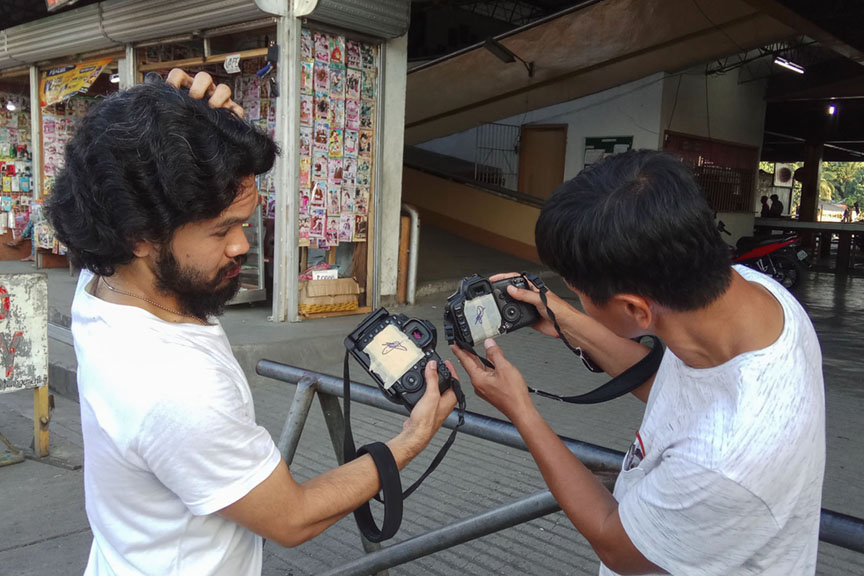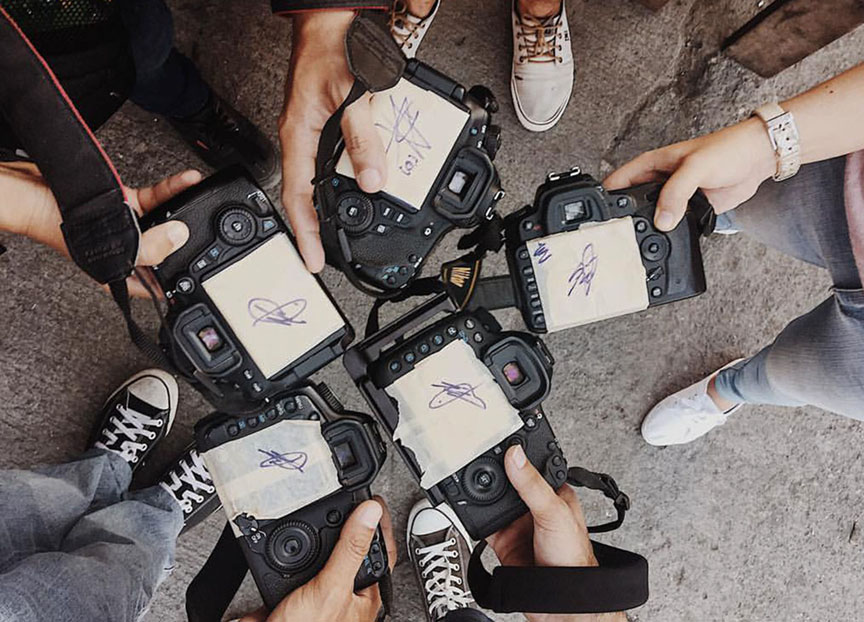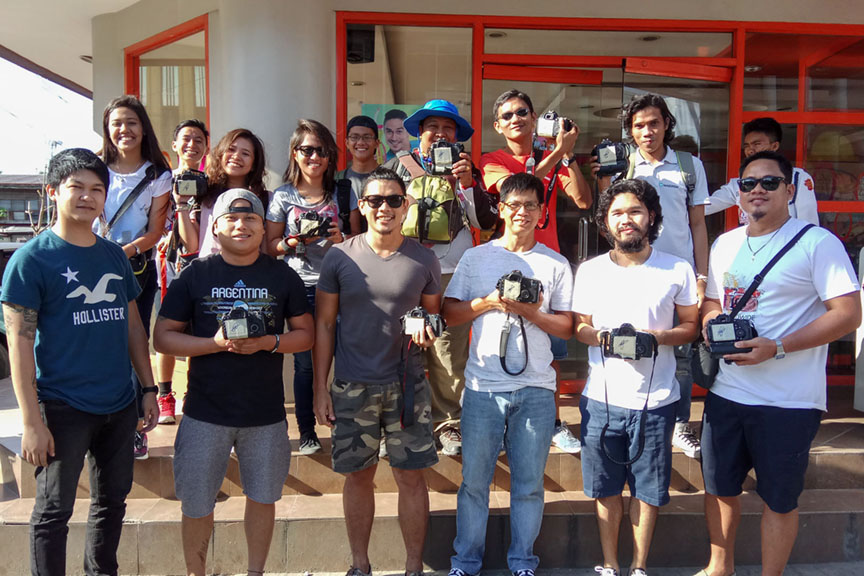ILIGAN CITY (MindaNews / 08 April) – I’m an oldie when talking about photography.
If my memory serves me right, the first ever camera that I used was the Yashica FX-3 Super, released in 1979. It came with a normal (50mm) lens and a flash. I was in college working part-time for an NGO in the mid 1980s, and I was tasked to use this camera.
It was a film camera, of course, as digital was still decades away. It was a purely all-mechanical, all-manual camera. Meaning, you can use it without a battery. But you have to set all the controls manually – focus, ISO, aperture, shutter speed. There’s no point-and-shoot or “idiot” mode. But it has one button-type battery for the built in light meter, which could last for months, or even years.
 Author (right) and photojournalist Choy Romano “compare” pictures on their blocked out LCD monitors during a photowalk challenge mimicking shooting film last 25 March 2017. Photo courtesy of KENT DALZ
Author (right) and photojournalist Choy Romano “compare” pictures on their blocked out LCD monitors during a photowalk challenge mimicking shooting film last 25 March 2017. Photo courtesy of KENT DALZ
Thus, if you don’t know your photography, you’ll end up with wasted rolls and rolls of film, then blame the camera for giving you ugly, unusable pictures. So you won’t be wasting money on film, you have to learn your basics and get your shots right.
I read the Yashica’s manual cover to cover and in a few weeks, got my basics right. Months later, with more practice, my mind was continually gauging the ambient lighting condition, approximating aperture and shutter speed values and setting them even before I see a subject worthy of a snap. So that when I do find my subject, it’s just a matter of fine-tuning my exposure settings. And my fingers knew exactly how to turn the aperture ring in my left hand and the shutter speed dial in my right – either clockwise or counterclockwise, to match the built in light meter’s reading.
[Let’s not even discuss the process of developing a roll of film and making a print in the darkroom, which is way complicated, but more rewarding, than doing things in Photoshop]
So when I see youngsters wanting to learn photography, I want them to go through the process I went through. The point is not to torture them for my enjoyment, but to torture them so they’d know better, understand the process completely, so that when the shooting gets rough, they’d survive instead of just relying on the camera’s automated features and not understanding why they got their shots wrong.
So I’ve had this idea of a photowalk cum contest wherein we’d shoot the way it was during the time of film.
How exactly?
First, cover the LCD screen. Many photographers are overly dependent on the LCD monitor that they look at it after each shot. This overdependence on the LCD screen now has a name – “chimping” – because the photographer would say “ooohhh ohhhh ohhh” when looking at his shots. It’s not bad to chimp to check if you got the shot, but doing it too often will result in missed opportunities.
 NO LCD! Iligan City photographers show their cameras with the LCD monitors covered for a photowalk challenge mimicking shooting film last 25 March 2017. Photo courtesy of LANZ CHESTER ENTERINA
NO LCD! Iligan City photographers show their cameras with the LCD monitors covered for a photowalk challenge mimicking shooting film last 25 March 2017. Photo courtesy of LANZ CHESTER ENTERINA
I’d like to delay that suspense as we did during the time of film, until we had processed the rolls, usually days or weeks after we took the shot.
Second, set the camera exposure setting to Manual. No aperture- nor shutter-priority, no program, no idiot mode. So if you don’t know your exposure basics, sorry for you.
Third, limit ISO settings from 100 to 400. Back in the 1980s, these were the only films available. But it’s maybe 95 percent ISO 100 film for me, because I couldn’t afford the ISO 400. These days, photographers are overly dependent on high ISO settings on their expensive dSLRs, that sometimes I can just scratch my head why oh why would they shoot at ISO 3200 in broad daylight out there in the streets.
Fourth, limit the lens, to level the playing field some more. A long lens would give a better bokeh, or blurred background in a portrait, while an ultrawide lens’ perspective would have extra appeal. Thus, only the 18-55mm kit lens, or normal lens (50mm for the full frame shooter, 30/35mm for cropped sensors).
Fifth, limit to 100 shots only, roughly equivalent to three rolls of film. The point being, that if you have limited shots available to you, you’d think first before tripping that shutter release button. Did I get the settings right? Is this the best subject? how do I get the perfect timing? Like a sniper’s mentality – one shot, one kill. In my younger years as a photojournalist, I’d feel very comfortable when I had three rolls with me when covering an event. Now, hobbyists and photojournalists would shoot thousands of frames. It’s more shooting than thinking.
Finally, no Photoshop, of course. Submit your best three shots as they are. No post processing of any kind allowed, not even cropping. Our contests the past years had always been like this, to encourage mastering photography rather than Photoshop skills. Aside from the fact that you’d always end up with a better photograph if you already have a good picture to post process, compared to salvaging what little you can improve from a bad shot.
Sorry, but only dSLR users can join this contest, because mirrorless cameras will show you a lot in your electronic viewfinder.
We had this planned for some time in the local photography club, which we call The Umbrella (short for The Umbrella: Iligan’s Joint Photographers Society), but was only able to hold the photowalk and contest last March 25.
It was fun, and refreshing.
I myself have been relying mostly on my dSLR’s automatic aperture-priority setting, a habit that I got since film days because you could manipulate the aperture settings with your left hand, while your right is ready to shoot. Unlike shutter-priority where you have to use your right hand both to adjust settings and to take the shot. I thus had to practice shooting manual once more.
How I wish I had taken a video of the participants because practically all of us, after taking each shot, would automatically look at our LCD screens, only to be disappointed that we couldn’t see anything there.
 LOOK MA, NO LCD! Iligan City photographers show their cameras with the LCD monitors covered for a photowalk challenge mimicking shooting film last 25 March 2017. Photo courtesy of LANZ CHESTER ENTERINA
LOOK MA, NO LCD! Iligan City photographers show their cameras with the LCD monitors covered for a photowalk challenge mimicking shooting film last 25 March 2017. Photo courtesy of LANZ CHESTER ENTERINA
Some were overly worried they’d consume their 100 shots right away and ended up taking much lesser shots.
To my surprise, most of us nailed our exposure right.
But only 11 of us showed up. Maybe we’re the only ones who accepted the challenge because we’re confident we got our basics right?
All my three entries made it to the top 10, but photojournalist Choy Romano bagged the top two prizes, which came with cash, thanks to Umbrella member Jelo Pacaña who is now shooting weddings in New York City.
We’ve agreed to do this photowalk regularly. Why don’t you try this in your next camera club contest?
Let’s see what happens next time, if more would show up or not.
But surprise! If the others agree, I want even more torture – limit to only one roll (36 shots) and ISO 100. (Bobby Timonera / MindaNews)
